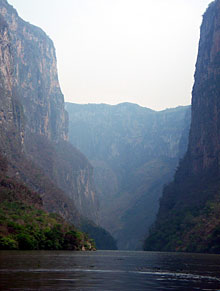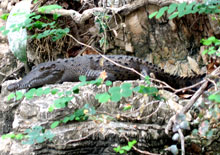There is a local legend revolving around Chiapas, Mexico’s, Canyon del Sumidero. Legend states that the local tribes were fanatic about remaining out of bondage. So in order to escape slavery by the Spaniards, they committed mass suicide by diving into the canyon, believing that they would be free in the afterlife if they did so.
There is some historical fact associated with this legend. When the Spanish first came to Mexico, they conquered the Aztec empire, which was located to the north and west of Chiapas for the most part. Later, when Cortes sent tax collectors to Chiapas, they were met with fierce resistance. Eventually, in a fierce battle between indigenous forces and Spanish conqueror Diego de Mazariegos, many Indian warriors threw themselves into the Canyon del Sumidero, preferring death to slavery.
This canyon is located in extreme southeastern Mexico, in the central state of Chiapas. It was formed by a fault that still runs through the canyon, through which the Grijalva river still runs. The river and canyon are the primary feature of what is now known as Cañón del Sumidero National Park. The Mexican government named the site a National Park in 1980, in order to protect the area around it, as well as the flora and fauna. The canyon is one of Mexico’s most beautiful features, though it is not well known outside the country. It is the central tourist attraction for the state of Chiapas; important enough that it features on the state’s coat of arms.
The park is formed by two features; the Canyon del Sumidero itself, and the plains that the canyon-forming Grijalva river runs through. A series of tremendous earthquakes thrust the plains in some places more than a kilometer above sea level millions of years ago. Some time after, the Grijalva river cut down through the basalt and granite, creating the canyon seen today.
A speed boat tour down the canyon and the Grijalva river leads to many beautiful sights. Lucky boaters might see some of the native American Crocodiles. One particular sight that any visitor would be lucky to see is what happens to the canyon during the rainy season. Nearby streams and trickles of water all lead down into the canyon and the sides of the canyon cascade with beautiful waterfalls.
The indigenous group modern Chiapans are descended from is the Maya. It is only a small part of the Maya empire that once was, but thanks to the state’s powerful cultural identity and independence, they have never felt really bound to the rest of Mexico.
The California Native’s tours of Chiapas include a speed boat tour through this beautiful canyon.
